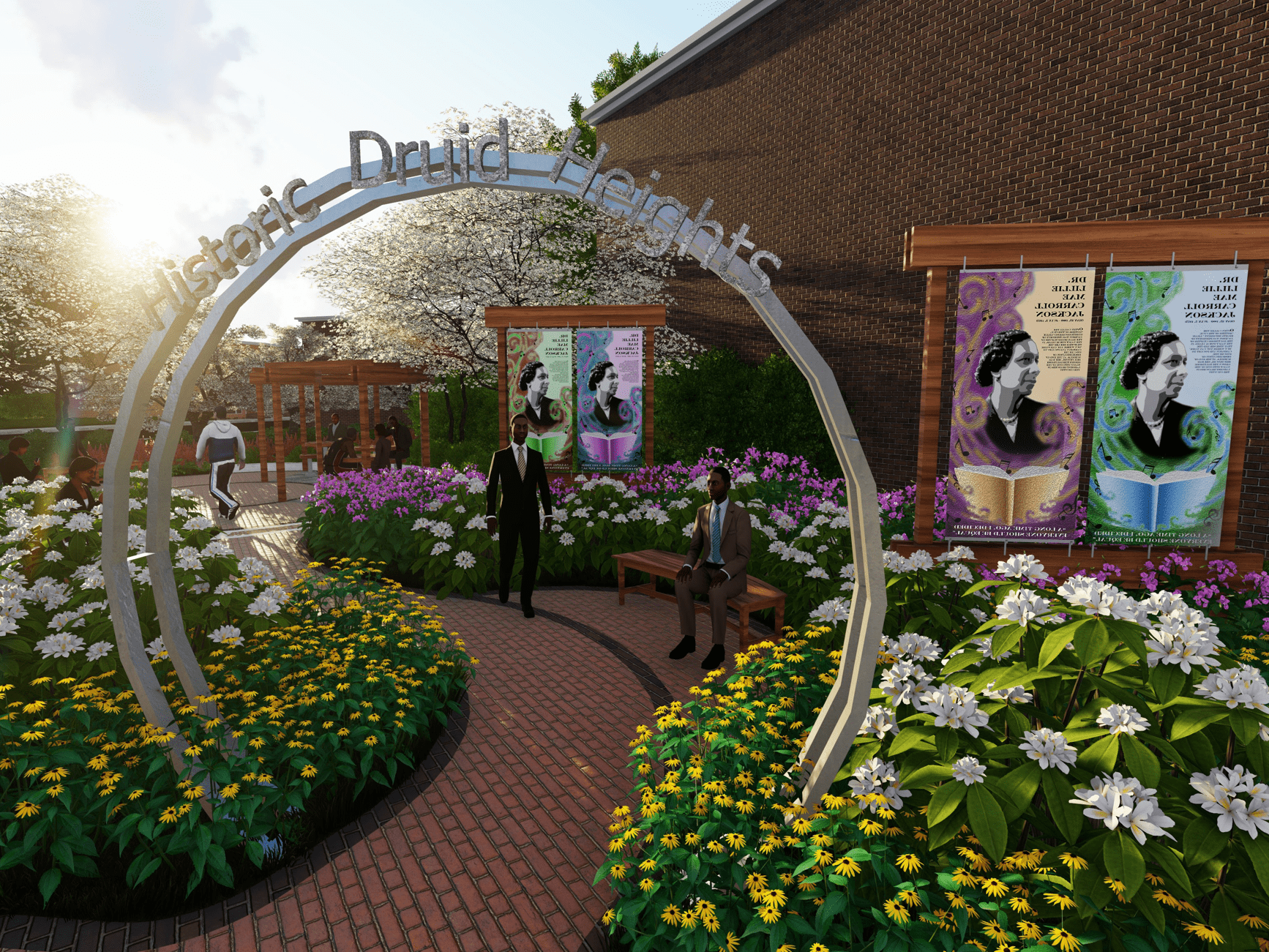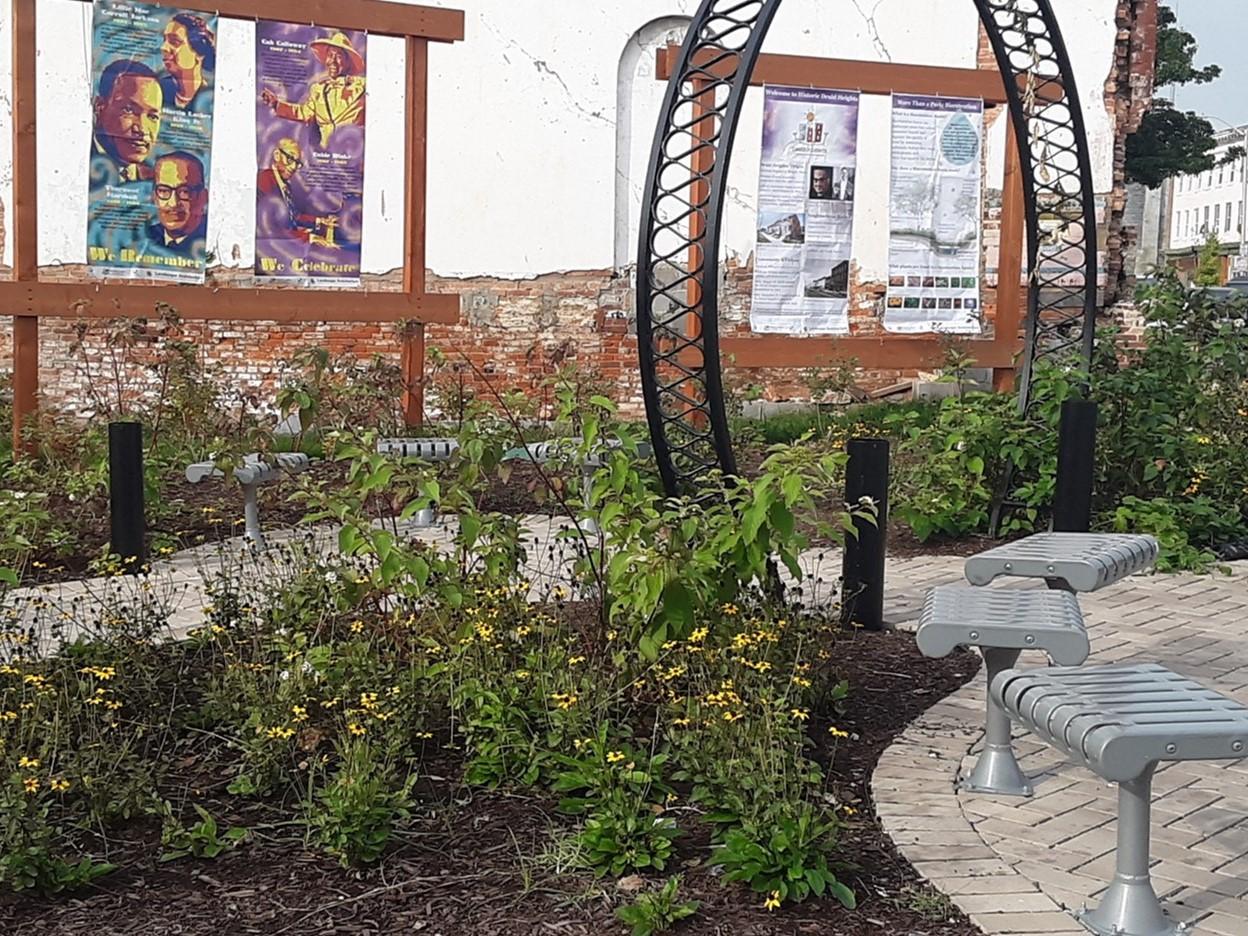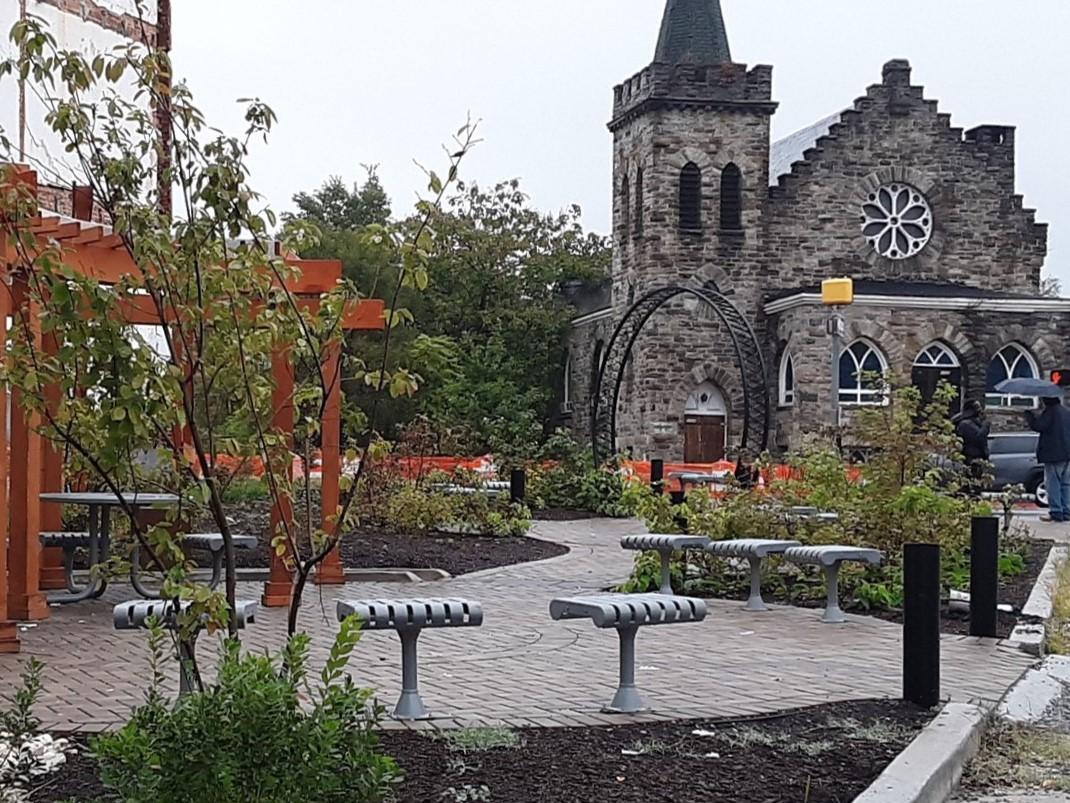New park incorporates stormwater management as a prominent design feature to raise awareness and improve the health of the Chesapeake Bay
The Druid Heights Community exploring Archway Park
Image Credit: University of Maryland
As part of a long-standing partnership between Byoung-Suk Kweon, associate professor in Landscape Architecture at UMD, and the Maryland Department of Natural Resources (DNR), students led the design on a new park to replace blight in Druid Heights, Baltimore, while partnering with the community to make the park a reality. The new Archway Park not only serves as a welcome mat and gateway to Druid Heights, but plays an important ecological and educational role, highlighting all native plants that promote pollinator health and making stormwater management a central design component that draws attention to how stormwater affects the health of cities and the Chesapeake Bay. This project is only the beginning of an ongoing effort for the community by the community to revitalize Druid Heights, with UMD as a facilitator and driving force.
“Revitalizing this corner shows the residents that we can start right here at the top of the neighborhood, the archway of the community, and make some changes that will spread throughout. The residents will defend the space and celebrate the legendary people from historic Druid Heights,” says Anthony Pressley, executive director of the Druid Heights Community Development Corporation (CDC). “We are considering this a signature park for Druid Heights and Baltimore city at large,” continues Johndre Jennings, director of real estate development for the Druid Heights CDC. “This space used to be blight, but we were able to work with Dr. Kweon’s students to create a design that really compliments our vision for the community.”

As Ryan Young describes it, a senior undergraduate in the Landscape Architecture program who spearheaded this work in class and as a yearlong internship to see the project through to completion, “This work was as community driven as we could make it. We really wanted it to be their park, and we were just helping facilitate the construction and design. Mr. Pressley called this park a ‘welcome mat’ for the community, so we really took that seriously when we thought about our designs.”
As part of the LARC240 studio class, this project was assigned by Kweon to her students. Working as an entire class with the community, her eighteen students presented designs at the end of the semester for the community’s input, and Young’s design was one of two (with the other designed by Mia Manning) that were chosen to be combined to create the final design for Archway Park. Young and Manning worked together to combine their designs and gather additional community feedback as part of a summer and fall semester internship following the class. Then, Young stayed on one more semester to see the project through every aspect of its development, from construction to plant selection. “It was really exciting to see it all come together,” says Young. “The contractors built using our drawings, which was both terrifying and amazing. It was a great learning opportunity to get such real-life experience with all the hands-on elements of the project.”

In addition to incorporating the history of the Druid Heights community into the design by including educational banners on prominent residents of the neighborhood from Eubie Blake to Cab Calloway, ecology and stormwater management are featured on educational banners (designed by Maria Espinoza, a master’s student in Landscape Architecture) and are central to the design of the park itself. As a design feature, Archway Park is actually graded so that when it is raining, you can sit under the covered pergola and watch the water being guided down the path and into a drain that carries it all around and underneath you, eventually swirling and channeling into a rain garden and rain barrels to infiltrate the water and feed the native plant life.
“You are taking in aesthetics and community desires, but a big part of it is the ecological functions of the spaces we’re making. I took the stormwater approach with my design which is what caught the eye of Sandi Olek with DNR [a partner and funder in this project]. The idea was that the more people who are aware of stormwater management and start thinking about where stormwater goes, the more people will actually care about this as an issue and be more open to projects that try to address it.”

In addition to funding from DNR’s Chesapeake Bay and Coastal Bays Trust Fund, the community secured funding from the Department of Housing and Community Development to make this space ecologically and socially functional, while adding value to the community and acting as a draw for future development.
“This is a community that is committed to revitalizing their neighborhood, and at the same time, they really get the value of green space,” says Sandi Olek, environmental planner with DNR. “As a funding agency, we have larger Bay restoration goals, and although this project is small, it is the cumulative impact of many projects like this that will make a difference. The partnership with Dr. Kweon and the green plan she and her graduate student [Che-Wei Yi] worked on for the community has made this area a priority for the city and for us. Every little thing you can do is going to help with community health, biodiversity, climate resiliency, as well as Bay restoration, so it’s a great opportunity.”
“Before developing the partnership between our college, DNR, and the community, there weren’t many landscape architecture projects, but what we really did was bring attention to the community to spark these initiatives,” adds Kweon. “Without the funding from DNR and community momentum, our designs are just pretty drawings. We have so many pretty drawings, but when our drawings can become reality, we really appreciate that.”
The opening ceremony for the park was combined with a community beautification day, showing the commitment of the Druid Heights community to promoting this and future work with the college. “It was really fun to have people come out and be sitting in our park on the benches that we placed surrounded by bushes that we had chosen, and then go straight from that to actively working to clean up the community using the park as a staging ground,” says Young.
Young adds, “It's not just art, it’s art with a purpose. That’s what has been so cool about landscape architecture is that it combines all these things like science, ecology, the environment, art, and creativity and brings them together into one discipline that can physically change the world. You can use it to improve people’s lives and try to make the world a better place.” Druid Heights is an example of this in action, with UMD giving their designs back to the community to make a real impact.